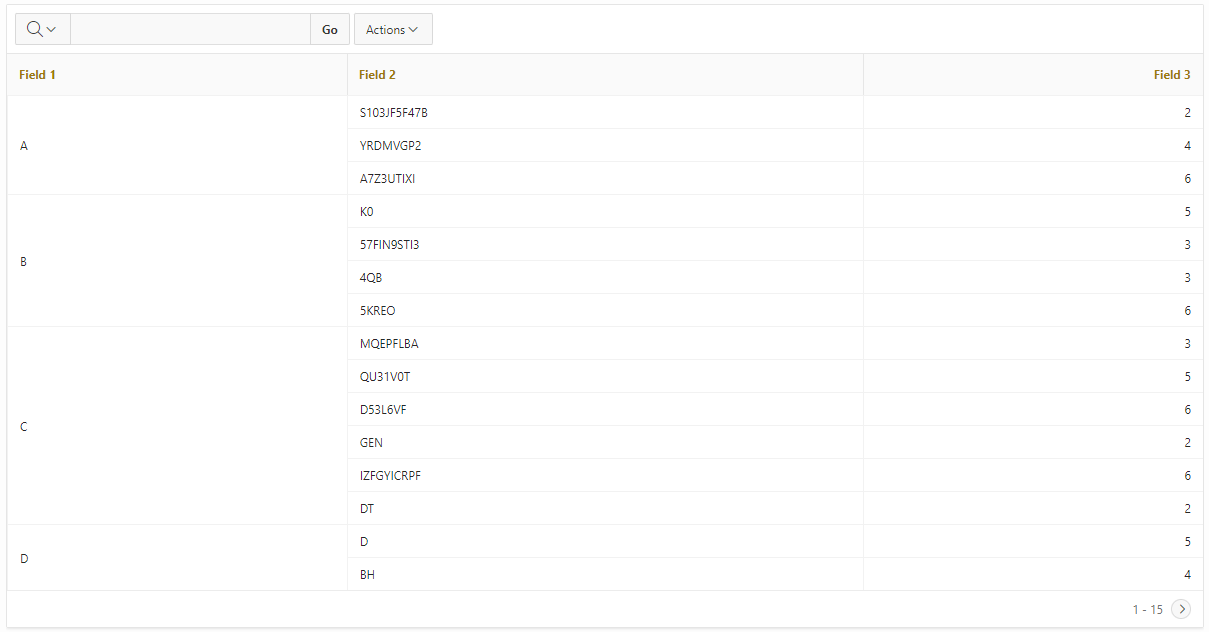Oracle Apex Interactive Report with rowspan
Let’s take a look on the resulting Interactive Report (IR). Grouping is done on Field 1.

Setup a IR with the following sample query:
with SAMPLE_QUERY as (
select DBMS_RANDOM.STRING('U', 1) FIELD_1
, DBMS_RANDOM.STRING('X', TRUNC(DBMS_RANDOM.VALUE(1, 12))) FIELD_2
, TRUNC(DBMS_RANDOM.VALUE(1, 7)) FIELD_3
from DUAL connect by LEVEL < 101)
select FIELD_1
, FIELD_2
, FIELD_3
, row_number() over (partition by FIELD_1 order by FIELD_1) as RN
, count(*) over (partition by FIELD_1 order by FIELD_1) as TR
from SAMPLE_QUERY
The important parts are the analytic functions in line #9 for the line row number (RN) and in #10 for the total lines per group (TR) as we will see in the jQuery part. When running the query, the result might look like this:
FIELD_1 FIELD_2 FIELD_3 RN TR
---------- -------------------- ---------- ---------- ----------
A 47YJ5R9S3N 5 1 2
A APRG 5 2 2
B SGD9QYZ7KB 6 1 4
B Z 3 2 4
B QGEFZE 2 3 4
B KAEL 4 4 4
C OSONEVXHYC 2 1 3
C 42KVNEXZKSE 6 2 3
C VC 3 3 3
D 6XLYT663 3 1 4
D Y30JQ0A7QIF 6 2 4
...
After setting up the query add a HTML Expression in the Column Formatting section of column FIELD_1:
<span class="ir-rowspan" data-rn="#RN#" data-tr="#TR#">#FIELD_1#</span>
With this markup we have everything setup for the JavaScript part. Run this code after PAGE LOAD and AFTER REFRESH with a dynamic action
apex.jQuery('.ir-rowspan').each(function () {
if (apex.jQuery(this).attr('data-rn') === '1') {
apex.jQuery(this).parent('td').attr('rowspan', apex.jQuery(this).attr('data-tr'));
} else {
apex.jQuery(this).parent('td').remove();
}
})
Or put the following code in a JavaScript file and run only the function rowSpan.init(); on page load
var rowSpan = rowSpan || [];
rowSpan = function () {
apex.jQuery('.ir-rowspan').each(function () {
if (apex.jQuery(this).attr('data-rn') === '1') {
apex.jQuery(this).parent('td').attr('rowspan', apex.jQuery(this).attr('data-tr'));
} else {
apex.jQuery(this).parent('td').remove();
}
})
}
rowSpan.init = function () {
// Run after ui elements rendered on page
apex.jQuery(window).on('theme42ready', function () {
rowSpan();
})
// Run after refresh of report
apex.jQuery(document).on('apexafterrefresh', function () {
rowSpan();
})
}
If the grouped column is the first one in an IR this class has to be set, too. Else the border isn’t shown correctly.
.a-IRR-table tr td:first-child {
border-left-width: 1px;
}

